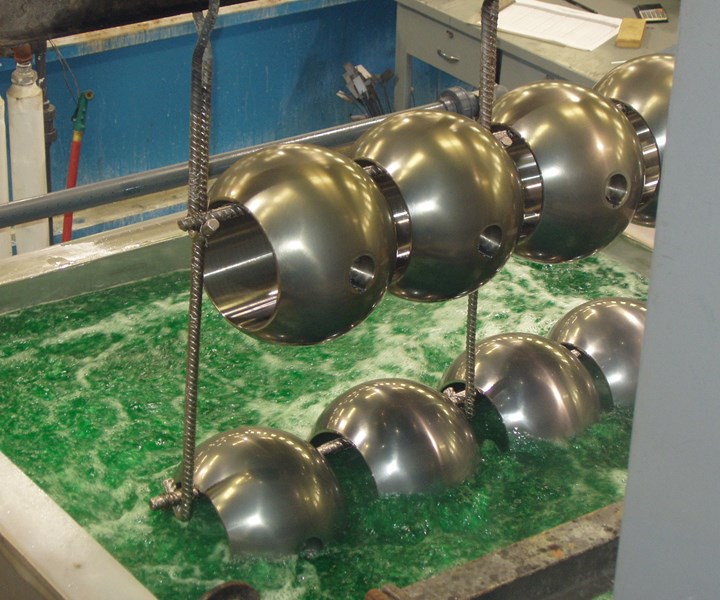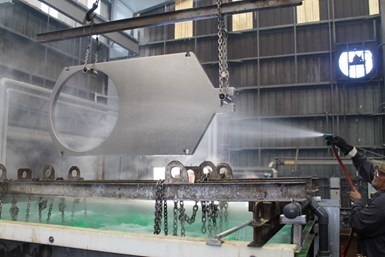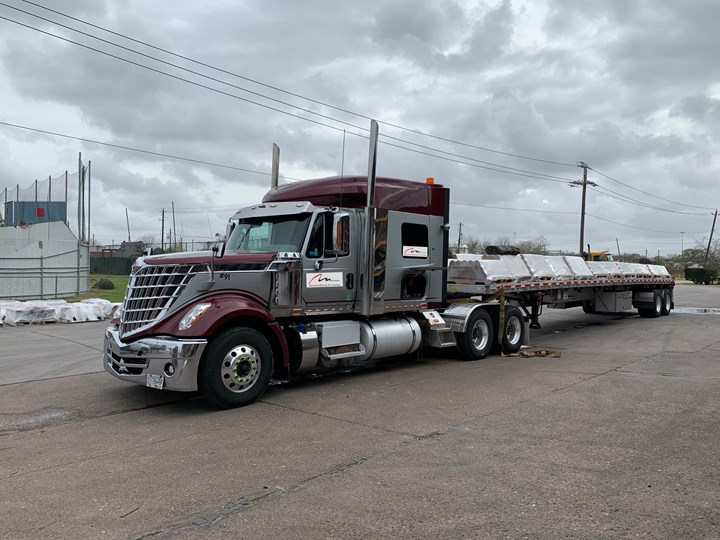
A finishing supply-chain program will only be effective if the coating company and OEM work collaboratively to devise a customized program based on the OEM’s core processes, procedures and overall logistics. Photos | Houston Platings & Coatings
Changes in technology, markets and competition have forced manufacturing companies and their suppliers to re-evaluate logistics to reduce production cycles. Many of these companies have found that re-engineering their supply chain can add significant value by reducing costs, cutting delivery times and increasing production. The result is a competitive advantage and enhanced customer relationships.
Often, however, the supply-chain implementation only looks at inputs to the production process and stops when the OEM’s physical manufacturing process is completed. Supply-chain concepts can and should be applied for the final step in the production process, the finishing phase, to help OEMs further cut costs and accelerate delivery schedules.
Under the direction of Dr. Barry Lawrence, Texas A&M’s Supply Chain Systems Laboratory performed a Vendor Managed Services supply chain study for Houston Plating & Coatings, which quantified the benefits from a supply-chain-based finishing program.
The results were dramatic: There can be significant direct cost savings from a well-designed and operated finishing supply-chain program, but the most significant benefit comes from the value of increased overall production. A supply-chain-based program that delivers benefits to its OEM customer may also enable the finishing company to resist downward pricing pressures from its OEM customer base. The study focused specifically on the benefits from a supply-chain satellite operation (where the coating functions are performed in the OEM’s plant), however, the principles can be applicable to many other types of supply-chain programs to achieve those same benefits.
A finishing supply-chain program will only be effective if the coating company and OEM work collaboratively to devise a customized program based on the OEM’s core processes, procedures and overall logistics. The finishing process is often the final step before shipment to the end user. Proper management of proven supply-chain principles for this phase can ensure that the order will be processed as quickly and as efficiently as possible, thereby increasing the total number of orders that can be delivered.
While each customer and each order are unique, some or all of the following features have been used by OEMs to reduce delays between production and finishing in order to get their parts processed and shipped as expeditiously as possible. We call these delays “points of friction,” and the goal of a supply-chain program is to produce as “frictionless” a process as possible.
Utilizing a Full-Service Vendor

By utilizing a finishing company that provides a full range of corrosion-protection services under one roof an OEM can significantly reduce costs.
A key component of an effective finishing supply-chain program is use of a full-service finishing company. Many OEMs produce parts that have varying finish specifications (the big reason they got out of, or never took on, in-house finishing in the first place). By utilizing a finishing company that provides a full range of corrosion-protection services under one roof — i.e., electroless-nickel (EN) plating, phosphate, passivating, salt-bath nitriding (SBN-QPQ) and various spray coatings — an OEM can significantly reduce redundant transportation and administrative costs. “One-stop shopping” for most of an OEM’s corrosion-protection requirements will produce other benefits, including consistency of application and quality.
Often, an OEM will need to meet multiple coating specifications for each order and, in some cases, multiple specifications for each part. Having all, or the majority, of those services in one location can eliminate days from the completion schedule by avoiding the need to send parts to multiple locations. Some companies have even been able to alter specifications to take advantage of more efficient processes — for example, EN plating or SBN-QPQ vs. hard chrome or gas nitriding — to further reduce completion times.
For most OEMs, vendor management is a significant cost. Utilizing a full-service finishing company can produce savings by reducing the number of vendor audits that an OEM’s sourcing department conducts annually.
Process Mapping
To develop a coatings supply-chain program, an OEM should first undertake a detailed study of the steps involved from the time of completion until the part is returned with the finish applied and inspected, challenging the amount of time required for each step. For instance, one OEM recently discovered that it was taking an average of four days from the manufacturing completion to the date the part was sent out for finishing. Paperwork, administrative tasks and poor warehousing (“friction”) were the key culprits. An effective coating supply-chain program that includes the supply-chain partner as a component member of the overall manufacturing process, and that turns over transportation issues to that partner, will eliminate many of those days from the completion schedule. The OEM will be able to ship more parts, avoid penalty clauses for late deliveries and potentially earn bonus fees for early deliveries.

As part of a supply-chain optimization program, the coating company should assume virtually all responsibility for transportation (with the exception of extremely heavy parts) in the proximate geographical area. Photo | Houston Platings & Coatings
Transportation
As part of a supply-chain optimization program, the coating company should assume virtually all responsibility for transportation (with the exception of extremely heavy parts) in the proximate geographical area. Scheduled daily/weekly pickup and delivery not only ensures that the parts are returned as quickly as possible after processing, but also eliminates a major administrative burden for the OEM. Hot-shot and expedited pickup/delivery service should also be available from the supply-chain coating partner for orders that have special requirements, or when standard pickup/delivery schedules are not optimal. Without these features, separate transportation POs and invoices must be initiated and processed for each order, thereby creating additional administrative burdens (“friction”) and wasted time.
An effective coatings supply chain plan not only eliminates a substantial direct cost for the OEM, but also produces a significant reduction in administrative costs. Removing transportation issues from the list of daily tasks enables OEM purchasing personnel to focus on more important matters, and keep the orders moving. Coordinated transportation with common carriers and scheduled deliveries can produce many of the benefits of a well-planned supply-chain program for customers that are outside the proximate geographical area.
Certified Inspections
On many occasions, major customers will require inspection of the coating application by certified inspectors. A finishing company that employs NACE-certified inspectors for quality control will help to ensure that the process is completed as smoothly and efficiently as possible. Certain specifications, like NORSOK (Norwegian oil industry) epoxy-coating standards, require NACE-certified inspectors to monitor the process(es). Utilizing a coating company that has these inspectors on staff can cut days from the completion schedule and eliminate a substantial additional cost to the OEM, which would otherwise have to pay for such inspections.
Consolidated Billing
For OEMs using standard costing, or for parts that are being processed for inventory, it makes little sense to process a separate PO and invoice for each order. In an effective coating supply-chain program, the finishing process becomes just another step on the original work order, thereby eliminating the need to produce a separate PO and invoice for each order. A record of the parts processed is entered in the OEM’s system to maintain traceability. Once each month, a single invoice for all the parts processed is prepared based upon preset pricing.
Many companies calculate the cost of preparing a PO and invoice to be well in excess of $125 per transaction. A consolidated billing process that is part of the supply-chain program can eliminate hundreds or even thousands of POs and invoices annually, not to mention the additional administrative time spent obtaining quotes for the purchase order. Payment of the invoice can be done electronically to further reduce administrative time. Typically, there are no minimum charges related to this type of billing arrangement.
Dedicated Personnel
For each OEM that has a significant volume of the same or similar parts, it is a good idea to have a dedicated team that coordinates an OEM’s orders and processes the parts. The experience and expertise developed by the team from working on the same parts with the same specifications ensures the highest accuracy and fastest processing. A dedicated coordinator or expeditor also ensures that any changes to the processing or delivery schedule are appropriately addressed and monitored.
Independent Machine Shops
Often, all or part of an assembly is prepared for the OEM by an independent machine shop. Under the direction of the OEM, a supply-chain program can be implemented with the machine shop to eliminate time and costs from the overall process through reduction or elimination of transportation and administrative costs in ways similar to those described above.
Typical Example: The following example is representatives of the types and amounts of cost savings that an OEM customer can realize from a supply-chain optimization program:
So how does the finishing company absorb those costs, since they must be borne by someone? An open PO program requires less administrative work by the coating company’s staff, as well, so that is a win/win for everyone. We have found that, at certain volumes, the marginal profit on additional business approaches 80-90%, so the additional transportation costs don’t necessarily produce an undue cost burden on the company if it results in a significant amount of additional business, which it typically does.
OEM Consolidation of the Coating Function
Many manufacturing OEMs utilize a number of different machine shops to meet their production schedules, and the finishing costs can vary greatly from machine shop to machine shop. Some OEMs have solved the problem by directing each machine shop to quote the job without regard to finishing costs and sending the parts to the OEM’s designated coating shop (typically on coating-shop supplied transportation). The coating company will then keep track of orders from the various machine shops and invoice the OEM directly once a month based on preset prices. The OEM can thus be assured of consistent quality and pricing. Machine shops typically mark up the finishing costs, so a consolidation program will enable the OEM to receive consistent pricing as well as the best pricing based on volume discounts for the additional work directed to the coating company.
Satellite Plants
For OEMs with very high volumes, it may be appropriate to create a satellite plant within an OEM’s production facility. In a satellite operation, the coating company provides all the equipment, supplies and personnel for the processes and is responsible for all environmental and disposal costs. The OEM supplies the space, which is typically adjacent to the production operations. Utilizing many of the items discussed above, an on-site satellite plant can produce maximum efficiency and flexibility, resulting in the fastest completion times possible.
A satellite operation is the ultimate in an overall finishing supply-chain program, because there are no shipping or administrative delays. Additionally, the OEM can direct the workflow to best suit its production schedules, thereby saving on expediting and overtime charges, which can be substantial when production schedules get stretched. But perhaps best of all, the vast majority of the work just flows without the need for any interaction between the OEM and the finishing company.
A finishing supply-chain program transfers many of the burdens, headaches and delays (“friction”) associated with the corrosion-protection phase of the production cycle to its coating supply-chain partner. This enables the OEM to focus on its core manufacturing processes. In addition to substantial direct cost savings, an effective finishing supply-chain program helps an OEM streamline the completion process by decreasing the finishing lead time. This, in turn, will lead to a greater number of completed orders per quarter, and a better on-time delivery record—a more important benefit, as demonstrated by the A&M study, than even the direct cost savings derived from a frictionless coating supply-chain program.
Finally, most finishing companies operate as job shops, and do not have long-term contractual arrangements — the next job from a customer is assured only to the extent that the last one was done on time and on budget. A supply-chain finishing program enhances customer relationships and reduces the OEM’s incentive to constantly shop for the cheapest price in the market, because it takes into account that doing so would mean the loss of the other benefits associated with a fully functioning supply-chain program.
As Adam Smith said over 200 years ago, the wealth of a nation is in what it produces. A coating shop that helps its customers produce more will not only increase its customer’s wealth but its own as well.
Related Content
Products Finishing Reveals 2024 Qualifying Top Shops
PF reveals the qualifying shops in its annual Top Shops Benchmarking Survey — a program designed to offer shops insights into their overall performance in the industry.
Read MoreConcrete Reinforced Bars Built to Last
Not all corrosion-resistant materials for infrastructure are created equally. Epoxy-coated steel rebar has advantages that other materials used to prevent corrosion do not.
Read MoreFinishing Systems Provider Celebrates 150 Years, Looks to Future
From humble beginnings as an Indiana-based tin shop, Koch Finishing Systems has evolved into one of the most trusted finishing equipment providers in the industry.
Read MoreRobots, AI and Superb BMW Surfaces
There isn’t an automotive paint shop in the world that doesn’t have post-paint inspection and defect processing. But BMW is doing this with levels of technology at a plant in Germany that exceed all other paint shops in the world.
Read MoreRead Next
Education Bringing Cleaning to Machining
Debuting new speakers and cleaning technology content during this half-day workshop co-located with IMTS 2024.
Read MoreA ‘Clean’ Agenda Offers Unique Presentations in Chicago
The 2024 Parts Cleaning Conference, co-located with the International Manufacturing Technology Show, includes presentations by several speakers who are new to the conference and topics that have not been covered in past editions of this event.
Read MoreEpisode 45: An Interview with Chandler Mancuso, MacDermid Envio Solutions
Chandler Mancuso, technical director with MacDermid Envio discusses updating your wastewater treatment system and implementing materials recycling solutions to increase efficiencies, control costs and reduce environmental impact.
Read More










.jpg;maxWidth=300;quality=90)











